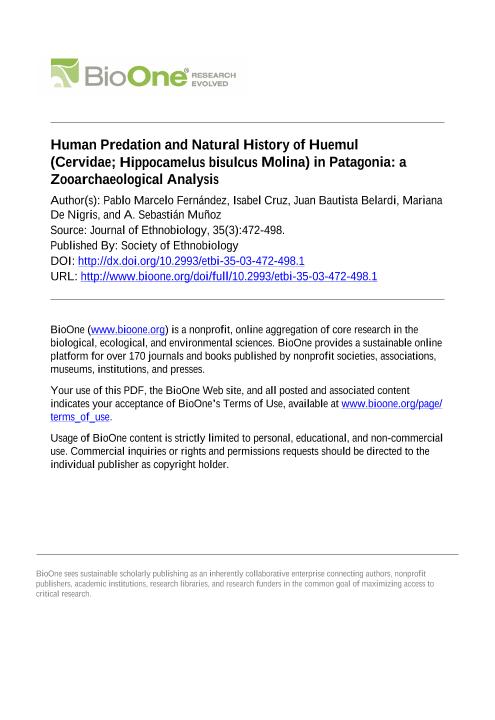Artículo
Human Predation and Natural History of Huemul (Cervidae; Hippocamelus bisulcus Molina) in Patagonia: A Zooarchaeological Analysis
Fernández, Pablo Marcelo ; Cruz, Isabel; Belardi, Juan Bautista
; Cruz, Isabel; Belardi, Juan Bautista ; de Nigris, Mariana Eleonor
; de Nigris, Mariana Eleonor ; Muñoz, Andres Sebastian
; Muñoz, Andres Sebastian
 ; Cruz, Isabel; Belardi, Juan Bautista
; Cruz, Isabel; Belardi, Juan Bautista ; de Nigris, Mariana Eleonor
; de Nigris, Mariana Eleonor ; Muñoz, Andres Sebastian
; Muñoz, Andres Sebastian
Fecha de publicación:
10/2015
Editorial:
Society of Ethnobiology
Revista:
Journal of Ethnobiology
ISSN:
0278-0771
Idioma:
Inglés
Tipo de recurso:
Artículo publicado
Clasificación temática:
Resumen
We use published zooarchaeological evidence to discuss the various hypotheses concerning the past distribution of huemuls in Patagonia, southern South America. We then use these data to evaluate the interactions between this cervid and hunter-gatherers during the Holocene. The zooarchaeological record shows that huemul mainly inhabited forested and forest-steppe ecotonal environments during the Holocene. Huemul were hunted in exceptional circumstances during the early occupation of Patagonia. Its presence in the zooarchaeological record of South Patagonia increases after 9500 BP and is more frequent after 2200 BP. However, the taxonomic contribution of the species' bone remains to the archaeological record is always low. The few assemblages where there are a high number of huemul bones would have been the result of opportunistic hunting episodes. This in turn suggests that hunting of huemul had little or no influence on the animal's regional distribution over time. However, the progressively greater human presence in some forested areas towards the end of the Holocene could have affected huemul populations at the local scale. The zooarchaeological information presented in this paper illustrates interspecific and long-term relationships and, hence, could serve as essential information in future management strategies for huemul in Argentina and Chile.
Archivos asociados
Licencia
Identificadores
Colecciones
Articulos(IDACOR)
Articulos de INSTITUTO DE ANTROPOLOGIA DE CORDOBA
Articulos de INSTITUTO DE ANTROPOLOGIA DE CORDOBA
Articulos(SEDE CENTRAL)
Articulos de SEDE CENTRAL
Articulos de SEDE CENTRAL
Citación
Fernández, Pablo Marcelo; Cruz, Isabel; Belardi, Juan Bautista; de Nigris, Mariana Eleonor; Muñoz, Andres Sebastian; Human Predation and Natural History of Huemul (Cervidae; Hippocamelus bisulcus Molina) in Patagonia: A Zooarchaeological Analysis; Society of Ethnobiology; Journal of Ethnobiology; 35; 3; 10-2015; 472-498
Compartir
Altmétricas



